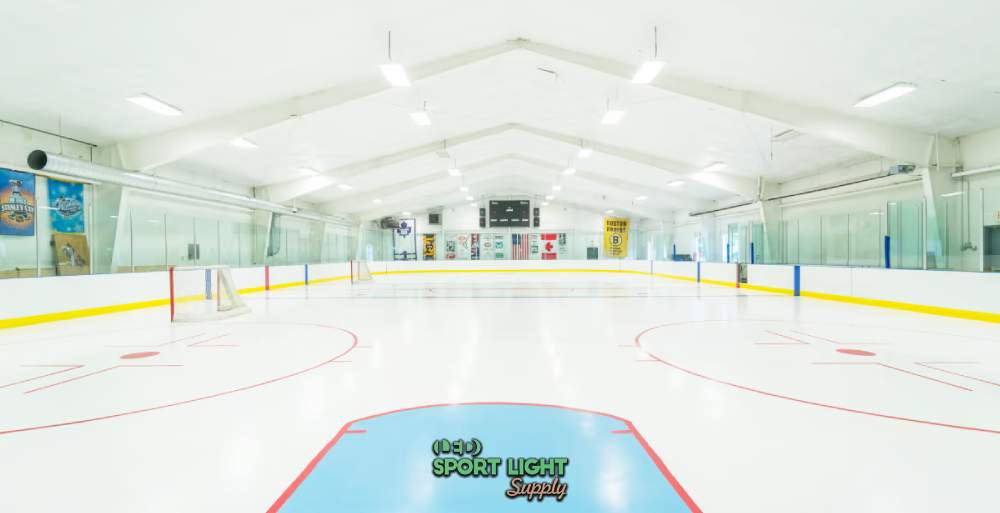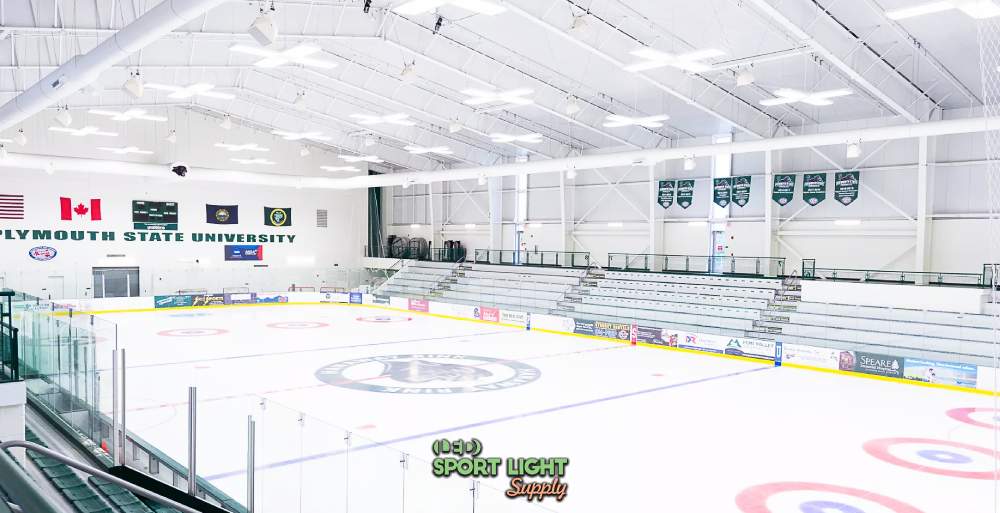The unique lighting demands of ice hockey, including the need for high-intensity lighting, precise color rendering, and resilience to low temperatures and moisture, make rink lighting a specialized field.
Table of Contents
ToggleFor players, the clarity of the ice surface is crucial. Proper lighting reduces glare and shadows, which can obstruct players’ vision and impact their performance. High-quality lighting helps in maintaining a uniform playing surface by minimizing visual distortions, thereby supporting precise movements and strategic plays. Moreover, well-lit rinks ensure that players are less likely to experience accidents caused by poor visibility, thereby enhancing safety.
For spectators, the visual appeal of the game is greatly influenced by the rink’s lighting. Bright, even illumination enhances the viewing experience, making the game more enjoyable and engaging. In professional leagues, where the experience is broadcasted to a global audience, superior lighting ensures that the play is captured in high definition, providing a clear view of the action for fans watching both in the arena and at home.

Ice hockey rinks demand a high level of illumination to ensure optimal visibility and performance. The recommended lux level for ice hockey rinks typically ranges between 1,500 to 2,500 lux. This level of brightness is crucial for maintaining the clarity of the ice surface, allowing players to see the puck and their teammates with precision.
High lux levels are necessary because ice hockey is a fast-paced sport where players must make quick decisions and react rapidly. Adequate illumination ensures that every detail on the ice is visible, reducing the chances of missed passes or collisions caused by inadequate lighting. The intensity of light must be sufficient to penetrate the ice surface and illuminate the players’ movements without causing visual distortion.
Uniform lighting is essential in ice hockey rinks to avoid shadows and bright spots on the ice surface. Shadows and uneven illumination can create visual distractions and impact players’ ability to track the puck and their opponents. To achieve uniform lighting, fixtures should be strategically positioned to cover the entire rink evenly. Advanced lighting systems employ high-performance LED floodlights and reflector fixtures to minimize glare and ensure that every inch of the ice is equally lit. This uniformity supports consistent gameplay and enhances both player performance and spectator experience.
Color temperature is a critical factor in ice hockey rink lighting, influencing both player performance and the quality of the viewing experience. The ideal color temperature for ice hockey rinks falls within the range of 4,000K to 5,000K. This color temperature range provides a bright, neutral light that closely resembles natural daylight.
The chosen color temperature plays a vital role in enhancing visibility on the ice. A neutral white light with a color temperature of 4,000K to 5,000K ensures that the ice appears white and the puck stands out clearly against it. This contrast is essential for players to track the puck’s movement accurately and for referees to make precise calls. The clarity provided by this color temperature range helps players perform at their best by reducing visual strain and improving their ability to make quick decisions.
In addition to improving visibility for players, the right color temperature also benefits spectators and broadcasters. Properly chosen color temperature minimizes glare, which can be a significant issue in ice hockey rinks, especially when using high-intensity lighting. For broadcasters, a color temperature within this range enhances the clarity and quality of televised footage, ensuring that viewers get a true representation of the game. This is particularly important for high-definition broadcasts where color accuracy and visual detail are paramount.

Ice hockey rinks present unique environmental challenges, including extremely low temperatures and high humidity levels. LED fixtures designed for rink use are engineered to withstand these conditions. They are constructed with robust materials and sealed to prevent moisture ingress, ensuring reliable performance in the harsh rink environment. Their ability to function efficiently in cold temperatures without a reduction in light quality makes them ideal for ice hockey applications.
Modern LED systems for ice hockey rinks come with advanced control systems that offer flexibility and efficiency. These systems allow for precise adjustments of light levels and color temperature to suit different needs, from practice sessions to game nights. Dimmer controls can be used to adapt the lighting for various activities and events, while automated systems can adjust the lighting based on the time of day or specific requirements of the event. This level of control enhances the versatility of the lighting setup and contributes to energy savings.
High-performance LED floodlights are the primary choice for illuminating ice hockey rinks. These fixtures are designed to deliver high-intensity, uniform light over large areas, making them suitable for the expansive ice surface. They are available in various wattages and configurations to meet the specific needs of different rinks. Features to look for include high lumen output, adjustable beam angles, and durable construction to withstand the rigors of rink environments.
For achieving optimal light distribution and minimizing glare, precision-engineered reflector fixtures are highly effective. These fixtures use advanced optical designs to direct light exactly where it is needed, ensuring uniform illumination across the ice surface. They are particularly useful in reducing light spill and controlling glare, which is crucial for maintaining clear visibility for both players and spectators.
The placement and mounting of lighting fixtures in an ice hockey rink are critical for achieving the best results. Fixtures should be positioned to minimize shadows and ensure even light distribution. Typically, lights are mounted on overhead structures or high walls around the rink. The height and angle of the fixtures must be carefully calculated to provide consistent illumination across the entire ice surface while avoiding direct glare into the players’ and spectators’ eyes.
Regular maintenance is essential to ensure the longevity and performance of rink lighting systems. Routine checks should include inspecting fixtures for signs of wear and tear, cleaning lenses to remove dust and debris, and ensuring that electrical connections are secure. Scheduled maintenance helps in identifying potential issues before they impact the lighting quality, thus preventing unexpected disruptions during games and practices.
LED fixtures are known for their long lifespan, which reduces the frequency of replacements and associated maintenance costs. High-quality LED lights can last up to 50,000 hours or more, significantly outperforming traditional lighting options. This longevity, combined with their resistance to cold temperatures and moisture, makes LEDs a reliable choice for ice hockey rinks, where consistent performance is crucial.
The transition to LED lighting for ice hockey rinks requires a significant initial outlay. High-performance LED floodlights cost between $500 and $1,200 each, while precision-engineered reflector fixtures range from $600 to $1,500 per unit. Given that a standard ice hockey rink typically needs between 20 and 40 fixtures, the total cost for purchasing LED lighting can range from $10,000 to $60,000. In addition to the cost of the fixtures, installation expenses must be considered, which can amount to $5,000 to $15,000. Therefore, the total initial investment for upgrading to LED lighting typically falls between $15,000 and $75,000.
Energy efficiency is a major advantage of LED lighting. LEDs consume 60% to 80% less energy compared to traditional lighting systems. For example, if a traditional lighting system uses 10,000 watts with electricity costing $1.00 per kWh, the annual energy cost amounts to around $87,600. Switching to LED lights, which consume 4,000 to 6,000 watts, would reduce the annual energy cost to approximately $35,040, resulting in annual savings of $52,560.
Maintenance costs also see a significant reduction with LEDs. Traditional lights typically need replacement every 10,000 hours, costing about $200 per fixture. For a system of 20 fixtures, this translates to an annual maintenance cost of approximately $8,000. In contrast, LED fixtures, which last up to 50,000 hours, reduce maintenance costs to about $2,000 annually due to fewer replacements.
The payback period for LED lighting is a crucial factor. It is calculated by dividing the total initial investment by the annual operational savings. With initial costs ranging from $15,000 to $75,000 and annual savings exceeding $60,000, the payback period can be as short as 0.25 to 1.25 years.
Long-term benefits continue to accrue beyond the payback period. LED lights offer a lifespan of up to 50,000 hours, which reduces replacement frequency and further lowers maintenance costs. The improved lighting quality not only enhances player performance but also elevates the spectator experience, potentially boosting revenue through increased attendance and better game experiences.
The upgrade to LED lighting for ice hockey rinks presents a compelling case for both immediate and long-term benefits. The initial investment, while substantial, is offset by significant savings in energy consumption and maintenance costs. The high efficiency and durability of LED fixtures lead to substantial operational savings and a relatively short payback period. Additionally, the enhanced lighting quality improves player performance and safety, while also enriching the fan experience. Over time, the superior longevity and reduced maintenance of LED systems ensure ongoing cost-effectiveness and reliability, making the transition to LED lighting a prudent investment for ice hockey rinks.
Drop us a line to receive a free lighting design